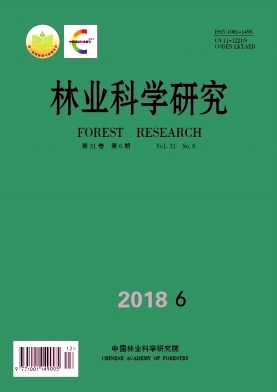-
金花茶(Camellia nitidissima Chi)为山茶科(Theaceae)山茶属(Camellia L.)金花茶组(Sect. Chrysantha Chang)植物,其花色金黄,富蜡质光泽,叶色碧绿,新叶紫红色,具有较高的观赏价值,为世界著名的珍稀植物、国家一级保护植物[1]。与山茶属山茶(C. japonica L.)、茶梅(C. sasanqua Thunb.)等相比,金花茶类花朵和叶片中含有类黄酮、茶多酚及茶多糖等多种活性成分,具有降血糖、降血脂、降血压和抗肿瘤等药理功效[2-4]。因此,金花茶化学成分的研究对进一步开发其药用、食用价值,提高经济附加值具有重要意义。
目前,关于金花茶化学成分的研究主要集中于类黄酮、多糖、多酚、皂苷等总含量及成分鉴定方面[5-7],而关于金花茶花朵、叶片化学成分含量及其变化特征尚不清楚,极大地限制了金花茶活性成分的开发利用。因此,本试验以金花茶花朵和叶片为材料,利用超高效液相色谱-飞行时间质谱联用(UPLC-QTOF-MS)技术分析金花茶花瓣、雄蕊、老叶和新叶中花青苷、类黄酮及儿茶素类等化学成分,明确其主要成分、含量及其变化特征,探讨其与花色、叶色之间的关系,以期为金花茶资源的进一步开发利用提供科学依据。
HTML
-
试验材料为金花茶老叶、当年生新叶和盛开期花朵;其老叶碧绿色,当年生新叶紫红色,花朵金黄色,花朵分为花瓣和雄蕊部分,所有材料均来源于中国林业科学研究院亚热带林业研究所山茶种质资源库。选取生长状况一致的金花茶5株,每株采摘树冠外围南面枝条上老叶、当年生新叶及盛开期花朵各3个进行试验。
-
标准品矢车菊素(纯度≥97%)、矢车菊素-3-O-葡萄糖苷(纯度≥99.05%)购于上海安谱实验科技股份有限公司;槲皮素-3-O-葡萄糖苷、槲皮素-3-O-芸香糖苷、槲皮素-7-O-葡萄糖苷、山柰酚-3-O-葡萄苷和天竺葵素-3-O-葡萄糖苷购于Sigma公司,纯度≥97%;儿茶素和表儿茶素购于北京索莱宝科技有限公司,纯度≥97%。有机溶剂甲醇、四氢呋喃、甲酸、丙酮、磷酸均购于国药集团化学试剂有限公司,色谱纯甲醇、丙酮、乙腈购于上海安谱实验科技股份有限公司。
-
试验仪器、设备为ACQUITYTM UPLC I-Class超高效液相色谱系统(Waters Corporation,Milford,MA,USA),Xevo G2-XS QTof MS质谱系统(Waters Corporation,Manchester,UK),UNIFI 1.8软件系统;Milli-Q-Gradient超纯水制备系统。
-
称取新鲜花朵、叶片各0.6 g,分别加液氮研磨成粉末,溶于甲醇:水:甲酸:THF(70:27:2:1,体积比)的提取溶剂2 mL[8],每隔12 h振荡1次,24 h后依次用滤纸及0.22 μm滤膜过滤,滤液保存在-20℃冰箱备用[9]。利用超高效液相色谱-飞行时间质谱联用(UPLC-QTOF-MS)技术对花朵和叶片中花青苷、类黄酮及儿茶素类等化学成分进行定性与定量分析。色谱柱为ACQUITY BEH C18(2.1 mm × 100 mm,1.7 μm),以0.1%甲酸水溶液(A)和乙腈(B)为流动相,洗脱程序为0~1.5 min,5% B;1.5~11 min,5%~40% B;11~14 min,40%~95% B;14~16.5 min,95% B;16.5~16.8 min,95%~5% B;16.8~20 min,5% B。电喷雾电离离子源(ESI),准确质量数用亮氨酸脑啡肽作校正液。离子化模式为正离子,离子源温度为120 ℃,脱溶剂气体为高纯度氮气,温度为450 ℃,流速为600 L·h-1,毛细管电压为1 kV,锥孔电压为40 V,扫描范围(m/z)为50~1 200 u。低能量扫描时电压为6 eV,高能量扫描时电压为20~45 eV。数据采集模式为Continuum模式。
-
建立儿茶素、表儿茶素、矢车菊素、矢车菊素-3-O-葡萄糖苷、槲皮素-3-O-葡萄糖苷、槲皮素-3-O-芸香糖苷和山柰酚-3-O-葡萄糖苷标准曲线进行定量计算(表 1),花青苷天竺葵素-3-O-葡萄糖苷按照矢车菊素标准曲线进行分析,类黄酮木犀草素-7-O-芸香糖苷和染料木苷按照槲皮素-3-O-葡萄糖苷标准曲线进行分析,重复5次,计算各成分含量。
化合物 Compounds 标准曲线 Standard curve R2 线性范围 Linear range /(μg·mL-1) 儿茶素 Catechin y=13 588.8x+101.611 0 0.999 5 0.00150 表儿茶素 Epicatechin y=16 379.2x+77.544 0 0.999 3 0.001100 矢车菊素 Cyanidin y=164 456.0x-126.993 0 0.999 2 0.000 420 矢车菊素-3-O-葡萄糖苷 Cyanidin-3-O-glucoside y=29 434.5x-0.376 0 0.999 6 0.000 210 槲皮素-3-O-葡萄糖苷 Quercetin-3-O-glucoside y=19 209.2x+51.142 4 0.999 3 0.00150 槲皮素-3-O-芸香糖苷 Quercetin-3-O-rutinoside y=45 456.4x+116.378 0 0.999 1 0.00150 山柰酚-3-O-葡萄糖苷 Kaempferol-3-O-glucoside y=21 177.9x+53.684 8 0.999 3 0.000 210 Table 1. Standard curve of 7 compounds
1.1. 试验材料
1.2. 试剂
1.3. 仪器与设备
1.4. 试验方法
1.4.1. 定性分析
1.4.2. 定量分析
-
利用超高效液相色谱-飞行时间质谱联用(UPLC-QTOF-MS)技术对金花茶花朵和叶片花青苷、类黄酮及儿茶素类等活性成分进行定性分析,根据UPLC-QTOF-MS和MS图谱,参考相关文献,对其主要成分进行结构鉴定,其质谱数据见表 2。共检测到10种主要成分,除成分4和成分10外,其余7种均有标准品作为对照。比对标准品,成分1和成分3分别为儿茶素和表儿茶素。成分2和成分6为花青苷,其中,成分2质谱数据为分子离子峰m/z值449.11,碎片离子m/z 287.06,判断其为矢车菊素-3-O-葡萄糖苷;成分6质谱数据为分子离子峰m/z值433.11,特征碎片离子m/z 271.06,判断其为天竺葵素-3-O-葡萄糖苷。
成分
No.Components保留时间
Retention time/min分子离子
Molecular ions(m/z)碎片离子
Fragment ions (m/z)化合物结构
Tentative identification1 3.56 291.09 247.06 儿茶素* Catechin 2 3.99 449.11 287.06 矢车菊素-3-O-葡萄糖苷* Cyanidin-3-O-glucoside 3 4.51 291.09 163.03 表儿茶素* Epicatechin 4 4.72 595.17 287.06 木犀草素-7-O-芸香糖苷 Luteolin-7-O-rutinoside 5 5.77 611.16 303.05 槲皮素-3-O-芸香糖苷* Quercetin-3-O-rutinoside 6 5.82 433.11 271.06 天竺葵素-3-O-葡萄糖苷* Pelargonium-3-O-glucoside 7 5.93 465.11 303.05 槲皮素-3-O-葡萄糖苷* Quercetin-3-O-glucoside 8 6.54 449.11 287.06 山柰酚-3-O-葡萄糖苷* Kempferol-3-O-glucoside 9 6.77 465.10 303.05 槲皮素-7-O-葡萄糖苷* Quercetin-7-O-glucoside 10 6.80 433.11 271.06 染料木苷 Genistin 注:*为有标准品对照的成分。
Note: *Represent the standard control compounds.Table 2. The UPLC-QTOF-MS data of the main compounds in the flowers and leaves of C. nitidissima
成分5、成分7、成分8和成分9均为类黄酮,分别是槲皮素-3-O-芸香糖苷、槲皮素-3-O-葡萄糖苷、山柰酚-3-O-葡萄糖苷和槲皮素-7-O-葡萄糖苷。无标准品对照的成分4质谱数据为分子离子峰m/z值595.17,特征碎片离子m/z 287.06,与张维冰等[10]鉴定木犀草素-7-O-芸香糖苷HPLC-MS结果相同,推定其为木犀草素7-O-芸香糖苷;成分10质谱数据为分子离子峰m/z值433.11,特征碎片离子为m/z 271.06,与李蓓佳等[11]鉴定染料木苷HPLC-MS结果相同,推定其为染料木苷。
-
金花茶花朵和叶片中花青苷、类黄酮与儿茶素成分含量见表 3。花青苷矢车菊素-3-O-葡萄糖苷主要存在于新叶中,花瓣和雄蕊中未检测到;天竺葵素-3-O-葡萄糖苷在叶片中的含量高于花朵,但花瓣和雄蕊中及老叶和新叶中含量均差异不大。类黄酮槲皮素-3-O-葡萄糖苷、槲皮素-7-O-葡萄糖苷、槲皮素-3-O-芸香糖苷和山柰酚-3-O-葡萄糖苷在花朵中的含量均远高于叶片,其中,槲皮素-3-O-葡萄糖苷在花瓣和雄蕊中含量无明显差异,槲皮素-3-O-芸香糖苷和山柰酚-3-O-葡萄糖苷在雄蕊中含量分别是花瓣中的1.59倍和1.96倍,槲皮素-7-O-葡萄糖苷在花瓣中含量是雄蕊中的7.13倍;木犀草素-7-O-芸香糖苷在花瓣中含量是雄蕊的3.32倍,新叶中含量是老叶的3.77倍;染料木苷在花瓣中含量高于雄蕊,新叶中含量高于老叶。表儿茶素是金花茶中主要儿茶素类成分,花朵中含量远高于叶片,老叶中含量为新叶的5.15倍。
μg·g-1 主要化合物 Main compounds 花瓣 Petals 雄蕊 Stamens 老叶 Old leaves 新叶 New leaves 矢车菊素-3-O-葡萄糖苷 Cyanidin-3-O-glucoside - - 0.01±0.00 11.02±1.22 天竺葵素-3-O-葡萄糖苷 Pelargonium-3-O-glucoside 15.45±1.23 17.43±0.31 22.59±0.40 25.95±3.71 槲皮素-3-O-葡萄糖苷 Quercetin-3-O-glucoside 88.05±1.16 91.80±2.34 3.29±0.20 1.38±0.05 槲皮素-7-O-葡萄糖苷 Quercetin-7-O-glucoside 6.92±0.18 0.97±0.05 - - 槲皮素-3-O-芸香糖苷 Quercetin-3-O-rutinoside 33.60±0.36 53.51±0.56 1.01±0.06 1.08±0.06 山柰酚-3-O-葡萄糖苷 Kempferol-3-O-glucoside 16.99±0.41 33.33±1.48 0.08±0.01 0.13±0.01 木犀草素-7-O-芸香糖苷 Luteolin-7-O-rutinosid 39.04±1.47 11.77±0.42 24.65±1.01 93.04±5.77 染料木苷 Genistin 2.33±0.08 0.18±0.01 3.58±0.23 7.93±0.42 儿茶素 Catechin 17.92±0.70 5.64±0.11 0.28±0.06 0.03±0.01 表儿茶素 Epicatechin 114.38±1.35 165.22±4.10 49.02±1.87 9.52±0.24 注:“-”表示未鉴定出。
Note: “-” not identified.Table 3. The contents of the main compounds in the flowers and leaves of C. nitidissima
金花茶花瓣和雄蕊中表儿茶素含量最高,天竺葵素-3-O-葡萄糖苷含量相对较低;花瓣中类黄酮成分含量较高的依次是槲皮素-3-O-葡萄糖苷、木犀草素-7-O-芸香糖苷和槲皮素-3-O-芸香糖苷,分别占其类黄酮总量的47.10%、20.89%和17.97%,山柰酚-3-O-葡萄糖苷和染料木苷低于10%;雄蕊中类黄酮成分含量较高的依次是槲皮素-3-O-葡萄糖苷、槲皮素-3-O-芸香糖苷和山柰酚-3-O-葡萄糖苷,分别占其类黄酮总量的47.92%、27.93%和17.40%,其余成分均低于10%。老叶中表儿茶素含量最高,天竺葵素-3-O-葡萄糖苷含量相对较高;老叶中类黄酮以木犀草素-7-O-芸香糖苷含量最高,占其类黄酮总量的75.59%,其次为染料木苷和槲皮素-3-O-葡萄糖苷,分别占其类黄酮总量10.98%和10.08%。新叶中矢车菊素-3-O-葡萄糖苷和天竺葵素-3-O-葡萄糖苷含量相对较高,表儿茶素较低;新叶中类黄酮以木犀草素-7-O-芸香糖苷含量最高,占其类黄酮总量的89.84%。
-
由金花茶花朵和叶片中花青苷、类黄酮与儿茶素成分总量(表 4)看出:花瓣和雄蕊中花青苷类含量相差不大,但分别为老叶中含量的68.36%和77.12%,新叶中含量的41.79%和47.15%;花瓣和雄蕊中类黄酮及儿茶素类含量均相差不大,但远高于叶片中,如花瓣和雄蕊中类黄酮含量分别为老叶的5.73倍和5.87倍,新叶的1.81倍和1.85倍;花瓣和雄蕊中儿茶素类含量分别为老叶的2.68倍和3.47倍,新叶的13.85倍和17.89倍。花瓣和雄蕊中总成分含量相差不大,但分别为老叶中的3.20倍和3.64倍,新叶中的2.23倍和2.53倍。花瓣和雄蕊总成分中花青苷类均最低(低于5%),类黄酮均最高(高于50%)。老叶总成分中儿茶素类、类黄酮和花青苷类分别占47.17%、31.20%和21.63%,新叶中相应分别占6.36%、69.00%和24.64%。
μg·g-1 化合物
Compounds花瓣
Petals比例
Proportion/%雄蕊
Stamens比例
Proportion/%老叶
Old leaves比例
Proportion/%新叶
New leaves比例
Proportion/%花青苷类 Anthocyanins 15.45 4.61 17.43 4.59 22.60 21.63 36.97 24.64 类黄酮 Flavonoids 186.93 55.86 191.56 50.43 32.61 31.20 103.56 69.00 儿茶素类 Catechins 132.30 39.53 170.86 44.98 49.30 47.17 9.55 6.36 合计 Total 334.68 100.00 379.85 100.00 104.51 100.00 150.08 100.00 Table 4. The total contents of the main compounds in the flowers and leaves of C. nitidissima
2.1. 花青苷、类黄酮和儿茶素定性分析
2.2. 花青苷、类黄酮与儿茶素定量分析
2.3. 花青苷、类黄酮与儿茶素总量分析
-
相关研究表明,槲皮素-3-O-葡萄糖苷、槲皮素-7-O-葡萄糖苷、槲皮素-3-O-芸香糖苷和山柰酚-3-O-葡萄糖苷等是金花茶花瓣中主要类黄酮成分[4, 12]。本试验利用超高效液相色谱-飞行时间质谱联用(UPLC-QTOF-MS)技术对金花茶花朵和叶片中的花青苷、类黄酮和儿茶素等成分进行分析,除已鉴定出的化学成分,还首次发现天竺葵素-3-O-葡萄糖苷、矢车菊素-3-O-葡萄糖苷、木犀草素-7-O-芸香糖苷和染料木苷等。本试验定量分析时,利用标准样品建立标准曲线,无标准样品的木犀草素-7-O-芸香糖苷和染料木苷按照槲皮素-3-O-葡萄糖苷标准曲线进行分析,试验重复5次,根据标准曲线计算各成分含量,分析结果表明,各成分含量均在标准曲线的线性范围内,说明本试验建立的金花茶花青苷、类黄酮和儿茶素等定量方法能准确有效定量各成分含量。
本试验中金花茶花瓣与雄蕊中花青苷含量相差不大,但叶片尤其新叶中花青苷含量远高于花朵;相反,叶片尤其新叶中儿茶素类含量远低于花朵,这可能主要与多酚类物质的合成途径相关,花青素通过花青素还原酶合成儿茶素,因此,金花茶新叶中花青苷含量明显高于老叶,而儿茶素类明显偏低,相关结果与应震等对红叶山茶‘金华美女’的研究一致[13]。金花茶花瓣和雄蕊中总黄酮及主要类黄酮槲皮素-3-O-葡萄糖苷、槲皮素-3-O-芸香糖苷和山柰酚-3-O-葡萄糖苷均相差不大,但远高于叶片。新叶中主要类黄酮成分木犀草素-7-O-芸香糖苷及总类黄酮含量明显高于老叶,可能主要由于新叶为生长活跃区域,次生代谢旺盛,导致花青苷、类黄酮等次生代谢产物增加,具体原因有待于进一步研究。
已有研究表明,茶树(C. sinensis (L.) O. Ktze.)紫色芽叶品种‘紫娟’中含有矢车菊素类、天竺葵素类和飞燕草素类花青苷[14-15],矢车菊-3-O-葡萄糖苷是红叶山茶品种‘贝拉大玫瑰’及其芽变品种‘金华美女’新叶中主要的花青苷,是导致其新叶显红色的主要原因[13]。本试验中,金花茶绿色老叶中仅含有天竺葵素-3-O-葡萄糖苷,而紫红色新叶中含有天竺葵素-3-O-葡萄糖苷和矢车菊素-3-O-葡萄糖苷,据此推断其新叶紫红色的原因可能与其含有的矢车菊素-3-O-葡萄糖苷有关。矢车菊素类花青苷是红色山茶花瓣中主要的花青苷成分[16-18],而槲皮素-3-O-葡萄糖苷和槲皮素-3-O芸香糖苷等类黄酮是金花茶花朵呈现黄色的主要原因。
植物中花青苷、类黄酮和儿茶素等具有生物活性,可用于杀菌、消炎、降“三高”和抗肿瘤等[19-21]。金花茶花朵和叶片原料丰富,叶片中的花青苷、类黄酮及儿茶素等生物活性成分具有抑制肿瘤、降“三高”、抗氧化、增强心血管和人体免疫力等生理功效[2-6],具有广泛应用前景,可用于医药、保健及功能性茶饮等。本试验利用超高效液相色谱-飞行时间质谱联用(UPLC-QTOF-MS)技术对金花茶花朵和叶片中花青苷、类黄酮及儿茶素等生物活性物质进行研究,明确其花青苷、类黄酮和儿茶素等成分含量及其变化特征,为进一步开发利用提供了科学依据。
-
本试验利用超高效液相色谱-飞行时间质谱联用(UPLC-QTOF-MS)技术对金花茶花朵和叶片中的花青苷、类黄酮和儿茶素等成分进行分析,共鉴定出2种花青苷、6种类黄酮和2种儿茶素类。首次在金花茶中检测到天竺葵素-3-O-葡萄糖苷和矢车菊素-3-O-葡萄糖苷,其中,矢车菊素-3-O-葡萄糖苷仅存在于金花茶紫红色新叶中。金花茶6种类黄酮成分中木犀草素-7-O-芸香糖苷和染料木苷为首次发现;槲皮素-3-O-葡萄糖苷、槲皮素-7-O-葡萄糖苷、槲皮素-3-O-芸香糖苷和山柰酚-3-O-葡萄糖苷为金花茶叶片中首次发现。金花茶中检测到儿茶素和表儿茶素,且以表儿茶素为主。槲皮素-3-O-葡萄糖苷等类黄酮是金花茶花朵呈现黄色的主要原因,而矢车菊素-3-O-葡萄糖苷是其新叶呈现紫红色的主要原因。





 DownLoad:
DownLoad: